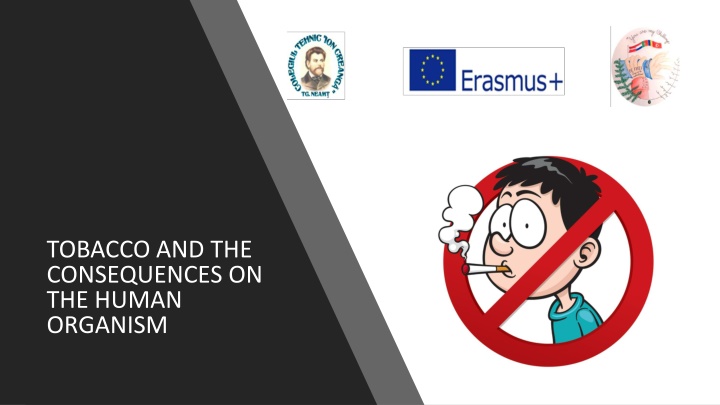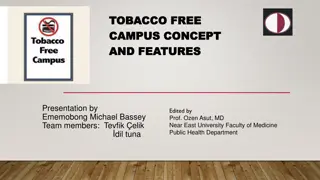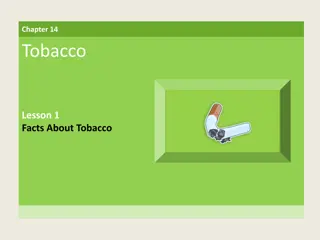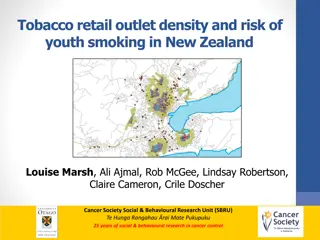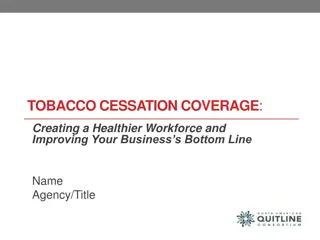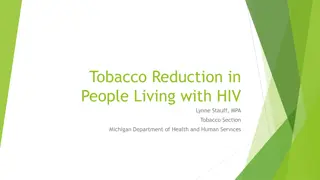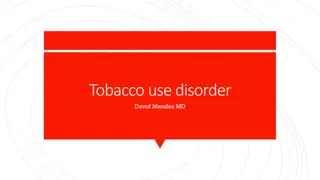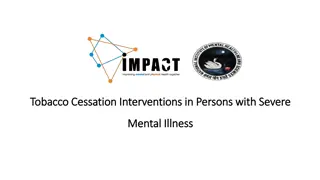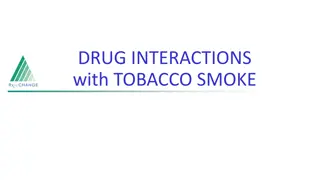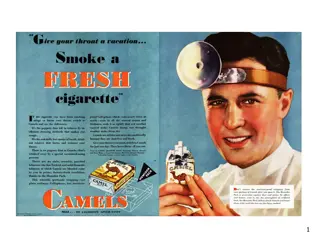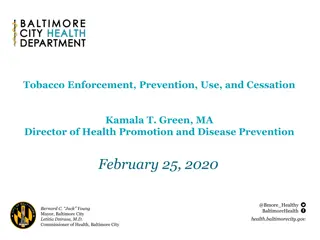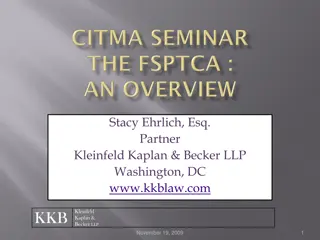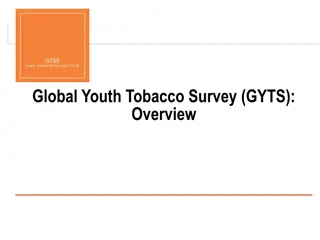Tobacco and Its Impact on Health
Tobacco, with its 4000 chemicals including nicotine, has short-term effects like high blood pressure and long-term consequences such as various cancers and heart diseases. Passive smoking and environmental pollution are also discussed in relation to tobacco usage. The use of electronic cigarettes among adolescents in Europe is on the rise, presenting a different perspective on smoking habits.
Download Presentation

Please find below an Image/Link to download the presentation.
The content on the website is provided AS IS for your information and personal use only. It may not be sold, licensed, or shared on other websites without obtaining consent from the author.If you encounter any issues during the download, it is possible that the publisher has removed the file from their server.
You are allowed to download the files provided on this website for personal or commercial use, subject to the condition that they are used lawfully. All files are the property of their respective owners.
The content on the website is provided AS IS for your information and personal use only. It may not be sold, licensed, or shared on other websites without obtaining consent from the author.
E N D
Presentation Transcript
TOBACCO AND THE CONSEQUENCES ON THE HUMAN ORGANISM
It is obtained by drying, chopping and processing the tobacco leaves. Tobacco is a complex mixture of substances. If most smokers are aware that it contains nicotine, just a few know that it contains 4000 other chemicals, among of which over 40 are carcinogenic. TOBACCO
A. Short term effects: -Psychological effects: nicotine has an impact over one s emotions and state of mind -Physical effects: High blood pressure Increased heart beat Weakened immune system Facial wrinkles Gastrointestinal effects Low skin temperature due to the poor peripheric blood circulation Dry cough, bad breath smell, mouth level infections Yellow spots on teeth and fingers Active smoking = inhaling the smoke produce by one s own cigarette
B. Long term effects: lung cancer, mouth cancer, oesophagus cancer, pharynx cancer, pancreas cancer, bladder cancer. heart diseases ulcer pulmonary emphysema
Passive smoking it is specific to the people who live and work in an environment polluted by other s cigarette smoke Effects: Irritations of the nose, the throat and of the chest Difficulties in breathing Coughing and sneezing Eye irritation (red eyes and tears). Headaches, dizziness and nausea Concentration disorders.
Smoking side effects: fires air pollution environment pollution with cigarettes buds
Electronic cigarette use among 14- to 17-year- olds in Europe Electronic cigarette (e- cigarette) use has been increasing worldwide among adolescents,1 but with differences between countries. According to a review with studies from 2013 to 2014, e-cigarette ever-use varied from 4.7% in Germany to 38.5% in Romania. Aceast fotografiede Autor necunoscut este licen iat n condi iile CC BY-ND
Vaping entails inhaling aerosolized particles (vapor) produced when a battery-driven heating element heats a glycerin-based liquid that often contains nicotine, flavoring or even illicit drugs. What Is Vaping? Vaping is different than smoking, as smoking requires a combustion reaction, while vaping does not. Many people erroneously believe that the chemical process underlying vaping is safer than smoking. Although this is partially true in some instances, there is no question that vaping is bad for vaping is bad for your health your health.
What Makes Teen Vaping So Popular? Many teenagers (and adults) erroneously believe that vaping nicotine is safer than smoking cigarettes, and e- cigarette and vape pen manufacturers have pushed this misperception to profit enormously. Teams of designers market eye-catching devices that appeal to teenagers. The fact remains that vaping, even without nicotine or illicit drugs, has no positive health benefits and poses substantial risks.
Is Vaping Better than Smoking Cigarettes? In most cases, vaping is not better than smoking cigarettes. Data suggests that vaping, even if nicotine or illicit drugs are not present in the vapor, predisposes teenagers to future addictive behaviors. A recent study of college students found that e-cigarette use is also significantly associated with illicit drug use and mental health problems.
Dangers of Teen Vaping The risks of vaping have been clearly identified in recent years. Vaping is associated with future nicotine and illicit drug use. The extremely popular JUUL e- cigarette holds about 72% of the vape pen market and offers a wide variety of enticing flavors. Each JUUL cartridge contains as much nicotine as one pack of 20 cigarettes. Some vape pens have also been shown to contain heavy metals and chemicals that are associated with cancer.
Conclusion 1. Both smoking and vaping have side effects and risks. Scientists do not fully understand the long-term health effects of electronic cigarettes (e-cigarettes) yet, but the science indicates that they are not a safe alternative to smoking. 2. The e-liquid typically contains humectants and flavourings, with or without nicotine; once vapourised by the atomiser, the aerosol (vapour) provides a sensation similar to tobacco smoking, but purportedly without harmful effects. 3. E-cigarettes contain a large dose of nicotine, a substance known to slow the development of brains in fetuses, children, and teens. 4. Smoking leads to disease and disability and harms nearly every organ of the body. 5. Vaping also delivers several dangerous chemicals, including diacetyl, cancer-causing chemicals, heavy metals, and volatile organic compounds (VOCs).
